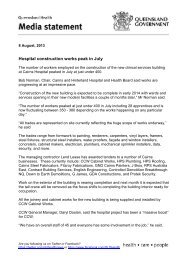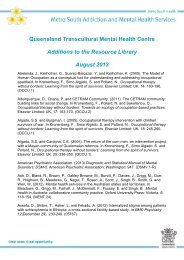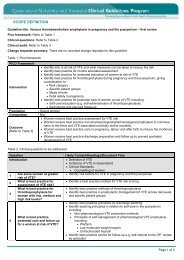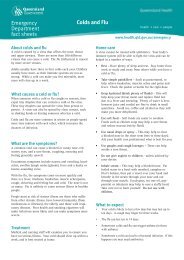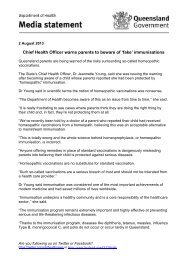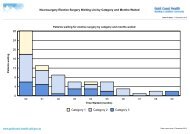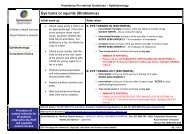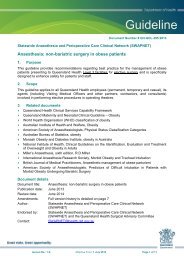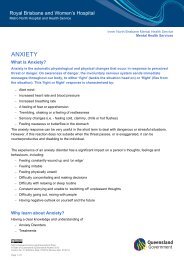Paediatrics - Queensland Health - Queensland Government
Paediatrics - Queensland Health - Queensland Government
Paediatrics - Queensland Health - Queensland Government
Create successful ePaper yourself
Turn your PDF publications into a flip-book with our unique Google optimized e-Paper software.
Ear problems<br />
2. Immediate management<br />
• Consult MO for referral to Paediatrician or ENT Specialist<br />
3. Clinical assessment<br />
• Obtain a complete patient history. See Assessment of the ear<br />
• Perform standard clinical observations<br />
• Perform physical examination. See Assessment of the ear<br />
596<br />
-- on otoscopic examination - white mass behind an intact ear drum:<br />
○ a deep retraction pocket with or without granulation and skin debris<br />
○ focal granulation on the surface of the drum, especially at the periphery<br />
○ perforation in the attic region (unsafe perforation)<br />
4. Management<br />
• If suspected refer ENT Specialist<br />
5. Follow up<br />
If confirmed, surgical treatment is required<br />
6. Referral / consultation<br />
Refer to Paediatrician and / or ENT Specialist<br />
Controlled copy V1.0<br />
Acute mastoiditis<br />
Recommend<br />
Urgent referral to hospital with paediatric and ENT Specialist for management<br />
Background<br />
Mastoiditis is inflammation in the mastoid air cells and typically occurs after acute<br />
otitis media<br />
Related topics<br />
Acute otitis media Ear wick technique for otitis externa<br />
Assessment of the ear<br />
1. May present with<br />
• As per Acute otitis media; in addition:<br />
-- may have systemic features - with fever and rigors<br />
-- pain swelling and tenderness above and behind the ear over the mastoid<br />
(bony prominence behind the ear)<br />
-- the ear may be pushed away from the head by swelling of the mastoid area<br />
-- dizziness or tinnitus (ringing in the ears) may be present<br />
2. Immediate management<br />
• Consult MO immediately<br />
3. Clinical assessment<br />
• Obtain a complete patient history. See Assessment of the ear<br />
• Perform standard clinical observations<br />
• Perform physical examination. See Assessment of the ear plus:<br />
- - palpate behind the ear. Palpate the mastoid tip noting any tenderness<br />
- - is the mastoid bone swollen and / or hot - describe<br />
- - palpate the occiput, around the ears, both sides of the neck for lymph glands<br />
Primary Clinical Care Manual 2011



